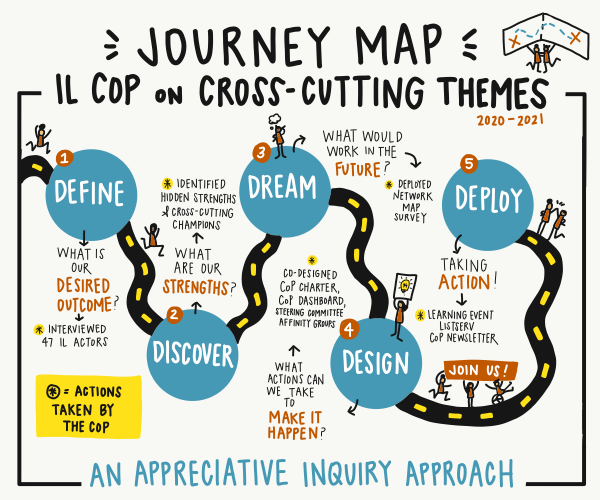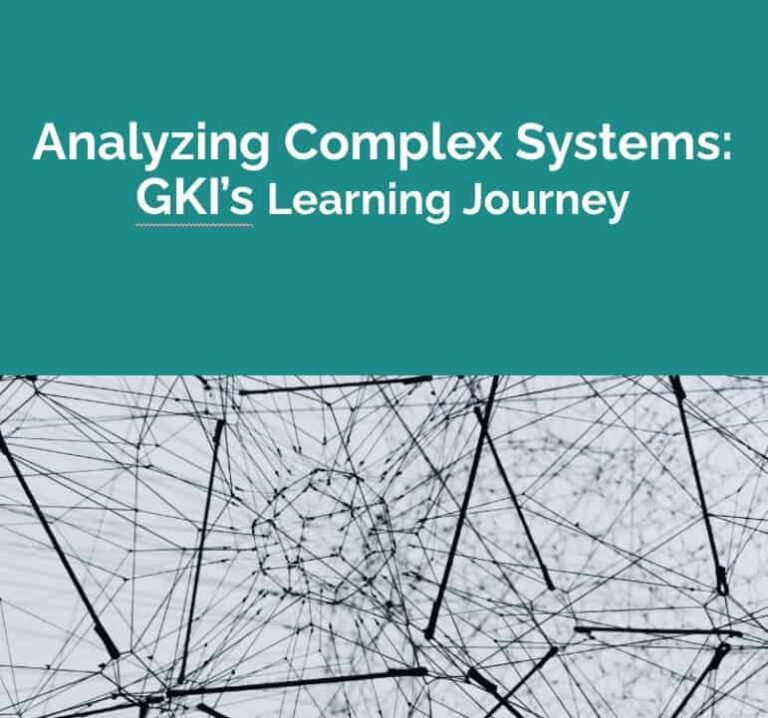Shifting from What’s Wrong to What’s Strong: An Appreciative Inquiry Approach
Written by Katie Safford with support from Alycia Ikegami and Whitney Stewart. Visuals created by Kat Haugh.
Did you know your brain is wired with negativity bias? We are predisposed to spot things that are not going well and feel an instinctual tug to fix them. As a result, researchers estimate that we spend about 80 percent of our time trying to fix what’s not working and only 20 percent of our time trying to build on our strengths [Source: Michelle McQuaid]. However, shifting our focus to strengths is not without its challenges.
Appreciative Inquiry (AI) is a transformational change approach grounded in philosophy, human sciences, and organizational change theories. At its foundations, it is an evaluative methodology. In contrast to other evaluative techniques, AI encourages us to view our work through a valuing lens, which focuses on existing strengths. AI invites us to envision ideal futures that build upon collective strengths rather than focusing on what’s missing.
I’m interested; how can I apply the AI approach?
AI asks questions that allow us to reframe challenges as opportunities and embrace storytelling, play, and imagination. To integrate an AI lens in your work, we recommend that you start by considering these three principles:
- Focus on positivity: This one is a given! An AI framework focuses on what worked best rather than what did not work. For example, ask your colleagues, “what are you most proud of?”
- Share to gain perspective: Sharing stories that emerge from positive inquiry can build appreciation and an understanding of the potential we could harness.
- Don’t be afraid to dream big: Don’t limit yourself by thinking about program design and implementation constraints. Imagine your ideal future.
The three principles above represent the underlying philosophy of the AI approach. If you are looking to delve deeper into actioning an AI approach, the 5-D cycle — pictured in the graphic at the beginning of this blog post — offers a practical model for approaching the change:
- Define — What is our desired outcome? In this step, it is essential to set the tone and purpose of the project by focusing on generative topics and discussing what value this project could bring. When put into action, this may look like a scoping exercise.
- Discover — What are our strengths? Discovery is a dialogue that is focused on strengths. This step allows participants to brainstorm assets and best practices.
- Dream — What would work in the future? Build upon the strengths identified in step two by imagining new possibilities and envisaging an ideal future. The output from this step might be a vision and strategic plan.
- Design — What actions can we take to make it happen? This step focuses on achieving the story and vision developed in the discover and dream steps. In this step, you will design your implementation approach.
- Deploy — Taking Action! The final step focuses on how we will deliver the design. The focus of this step is to create an action plan and decide on roles and responsibilities.
The AI approach in Action: Designing the Feed the Future Innovation Lab Community of Practice on Cross-Cutting Themes
Under the USAID’s Innovative Design Services (IDS) contract, the Global Knowledge Initiative(GKI) supports USAID’s Bureau for Resilience and Food Security to establish and facilitate the Feed the Future Innovation Lab Community of Practice (CoP) on Cross-Cutting Themes. The CoP aims to be a forum that facilitates shared learning around effectively integrating the consideration of cross-cutting themes — specifically gender and local capacity development — into agriculture research. Throughout the co-creation and implementation of this CoP, GKI is utilizing principles of AI to create a CoP that focuses on the unique and positive attributes of the Innovation Labs.
Due to the natural tendency toward negative bias, the CoP became bogged down by existing challenges and a new set of challenges brought on by COVID-19.
GKI helped to change this narrative by holding a learning workshop focused on shifting our mindset from what’s wrong to what’s strong.
We were joined by participants who were excited to utilize an Appreciative Inquiry (AI) lens. In the workshop, participants were asked to share strengths that their Innovation Labs discovered in the past year and to identify actionable steps that the CoP can take as a community to build on these strengths.

The most notable learnings from this workshop include:
- The Innovation Labs (ILs) that designed their projects considering local empowerment and sustainability were able to adapt to the travel restrictions imposed by COVID-19 much easier than the labs that did not because they already had strong relationships and supporting processes.
- Innovation Labs must engage local partners when discussing the integration of gender into agricultural research because gender is an integral part of a culture. The CoP network map further emphasized this point by identifying more CoP champions for gender integration in partner countries than those in the US.
To learn more, please reach out to us at info@gkinitiative.org!








